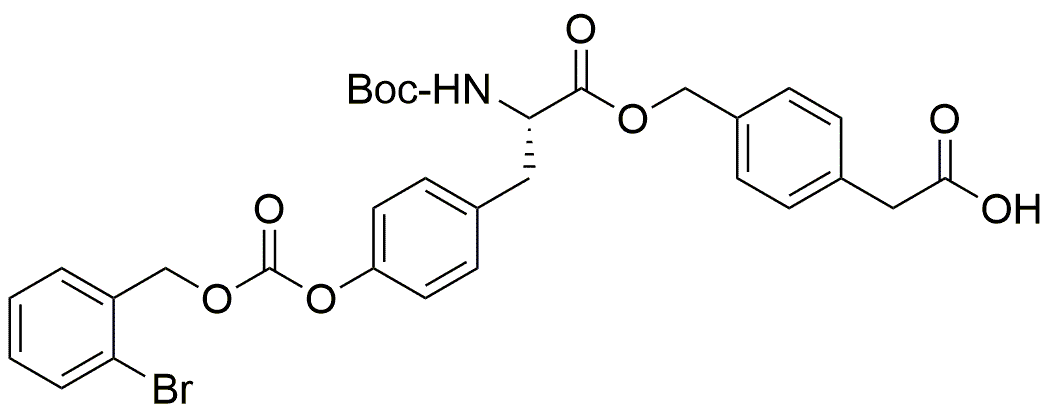Boc-L-Tyr(2-Br-Z)-O-CH2-Ph-CH2-COOH is widely utilized in research focused on:
- Peptide Synthesis: This compound serves as a key building block in the synthesis of peptides, particularly in the development of therapeutic agents. Its unique structure allows for the incorporation of brominated tyrosine, enhancing the biological activity of peptides.
- Drug Development: It is employed in the pharmaceutical industry for designing novel drugs, especially in oncology. The bromine substitution can improve the compound's interaction with biological targets, potentially leading to more effective treatments.
- Bioconjugation: The compound is useful in bioconjugation processes, where it can be linked to other biomolecules, such as antibodies or enzymes, to create targeted delivery systems for drugs or imaging agents.
- Research in Neuroscience: Its application in neuroscience research is notable, as it can be used to study the effects of modified amino acids on neurotransmitter systems, providing insights into neurological disorders.
- Analytical Chemistry: The compound is also valuable in analytical chemistry for developing assays that require specific interactions with proteins or enzymes, aiding in the detection and quantification of biomolecules.
General Information
Properties
Safety and Regulations
Applications
Boc-L-Tyr(2-Br-Z)-O-CH2-Ph-CH2-COOH is widely utilized in research focused on:
- Peptide Synthesis: This compound serves as a key building block in the synthesis of peptides, particularly in the development of therapeutic agents. Its unique structure allows for the incorporation of brominated tyrosine, enhancing the biological activity of peptides.
- Drug Development: It is employed in the pharmaceutical industry for designing novel drugs, especially in oncology. The bromine substitution can improve the compound's interaction with biological targets, potentially leading to more effective treatments.
- Bioconjugation: The compound is useful in bioconjugation processes, where it can be linked to other biomolecules, such as antibodies or enzymes, to create targeted delivery systems for drugs or imaging agents.
- Research in Neuroscience: Its application in neuroscience research is notable, as it can be used to study the effects of modified amino acids on neurotransmitter systems, providing insights into neurological disorders.
- Analytical Chemistry: The compound is also valuable in analytical chemistry for developing assays that require specific interactions with proteins or enzymes, aiding in the detection and quantification of biomolecules.
Documents
Safety Data Sheets (SDS)
The SDS provides comprehensive safety information on handling, storage, and disposal of the product.
Product Specification (PS)
The PS provides a comprehensive breakdown of the product’s properties, including chemical composition, physical state, purity, and storage requirements. It also details acceptable quality ranges and the product's intended applications.
Certificates of Analysis (COA)
Search for Certificates of Analysis (COA) by entering the products Lot Number. Lot and Batch Numbers can be found on a product’s label following the words ‘Lot’ or ‘Batch’.
*Catalog Number
*Lot Number
Certificates Of Origin (COO)
This COO confirms the country where the product was manufactured, and also details the materials and components used in it and whether it is derived from natural, synthetic, or other specific sources. This certificate may be required for customs, trade, and regulatory compliance.
*Catalog Number
*Lot Number
Safety Data Sheets (SDS)
The SDS provides comprehensive safety information on handling, storage, and disposal of the product.
DownloadProduct Specification (PS)
The PS provides a comprehensive breakdown of the product’s properties, including chemical composition, physical state, purity, and storage requirements. It also details acceptable quality ranges and the product's intended applications.
DownloadCertificates of Analysis (COA)
Search for Certificates of Analysis (COA) by entering the products Lot Number. Lot and Batch Numbers can be found on a product’s label following the words ‘Lot’ or ‘Batch’.
*Catalog Number
*Lot Number
Certificates Of Origin (COO)
This COO confirms the country where the product was manufactured, and also details the materials and components used in it and whether it is derived from natural, synthetic, or other specific sources. This certificate may be required for customs, trade, and regulatory compliance.

